Cart abandonment is a conundrum that haunts eCommerce stores far and wide. The truth is, it’s not just a “harmless” act of indecision—it can be a revenue slayer! Over the past years, businesses have discovered that cart abandonment emails can do wonders in retrieving lost sales.
But what makes a cart recovery email successful? With abandoned cart email templates available for grabs, how can a business create one that would stand out and actually work?
In this guide, we’ve collected the most captivating cart abandonment emails and dissected what makes each of them work. Other things we’ll discuss include:
- the reasons why customers leave their carts and don’t complete their purchases
- the proven effectiveness of abandoned cart emails
- our favorite cart abandonment email examples and why they work
- the elements that make an abandoned cart email work
- tips and best practices for cart abandonment campaigns
Whether you’re a seasoned eCommerce wizard or a small business owner experiencing your first bout with cart abandoners, get ready to be armed with the knowledge to tackle cart abandonment like a pro.
Common reasons for shopping cart abandonment

The average shopping cart abandonment rate is almost 70%. We have a collection of crucial shopping cart abandonment statistics showing just how huge this nemesis is.
Before going into the nitty-gritty details of recovering lost customers and rescuing abandoned carts, it’s important to understand why a customer abandons their cart in the first place.
Distractions and window shopping
The online window shopping experience is very different than physical window shopping. Customers can only go to one brick-and-mortar store at a time. However, in the online world, customers can hop from one eCommerce store to another by simply selecting a new tab.
From irresistible pop-ups, to memes, to messages from friends, and emails, the internet is brimming with endless distractions. Your customers might succumb to the allure, and end up leaving their carts unattended.
Unexpected costs
Ah, the infamous shipping fees and hidden taxes! When customers encounter unexpected or high shipping costs, taxes, and other hidden processing fees during the checkout process, they might backpedal and look for alternatives. Almost 50% of cart abandoners do so because the unexpected costs were too high.
Be upfront with pricing to win their hearts and conversions. Be transparent with shipping fees, handling fees, and all other fees. Try to provide at least a range if you cannot specify the exact shipping cost due to external factors.
More affordable options from competitors

Savvy online shoppers are more than willing to go the extra mile to find the best deal they can snag. They might add your products to their carts so they can easily come back to them later. Then, they will head to competitors to compare prices, read reviews, and look for great offers.
Complex checkout process
If your checkout process resembles a labyrinth, you might find customers fleeing. Long and confusing forms, excessive steps, or demanding unnecessary information can be major cart abandonment triggers.
According to Baymard Institute, the ideal checkout form should only have 12 to 14 elements. Despite this information, reports show that the average US eCommerce business checkout page has 23 up to 48 form elements.
No guest checkout options
Here’s a fact: when a new user visits your website, their goal is to buy something—not to create an account. If you require them to create an account, some customers might just choose to jump ship and buy elsewhere. In fact, eConsultancy reports that 25% of shoppers abandon their carts because they are forced to create an account.
What should you do? Always include a guest checkout option. Once they’ve completed the transaction, you can then invite them to create an account. Please don’t force them to commit to your brand right away.
Payment and security concerns
If customers doubt the security of your payment gateway or data handling, they may decide to think twice about completing checkout. Additionally, data privacy and identity theft have become more prevalent in recent years—in 2020, more than one million people in the US shared that they were victims of identity theft.
Slow site speed
There is a 4.42% drop in conversion rates for every additional second your website loads. Additionally, even just a one-second delay can cost millions in sales annually.
Essentially, an eCommerce website that loads slowly is basically a website that doesn’t want to sell. If the next step of the checkout process takes ages to load, shoppers may become impatient and decide to leave.
Not optimized for different devices

The world has gone mobile. When 2022 ended, mobile commerce sales hit the $3.5 billion mark. Additionally, more than half of shoppers now prefer mobile apps compared to other shopping channels because of their convenience and consistent interface.
Since mobile phones and tablets have become part of users’ daily lives, shopping has become something that can be done anywhere. It is predicted that by 2024, there will be more than 187 million active mobile shoppers in the United States alone. What does this mean? An online store that is not optimized for mobile devices is essentially an online store that doesn’t want to maximize sales.
The power of persuasive cart abandonment emails

A cart abandonment email, also called a cart recovery email is like a “friendly nudge.” It is an email sent to shoppers who have added products to their shopping carts yet left the online store without purchasing the items. The main objective of this email is to re-engage the shoppers and encourage them to complete their purchases.
While one reminder may be good enough to recover lost customers, most eCommerce brands resort to sending a series of automated emails called a “cart recovery flow.” This is essentially a system of emails that are sent within a number of days to continuously entice customers.
Do these emails work? Let’s check some of these numbers:
- Among the different types of email marketing campaigns and workflows, abandoned cart email flows generate the highest average revenue per recipient—which is $3.53. (Klaviyo)
- A workflow with three emails can generate almost 70% more completed purchases compared to only one email. (Omnisend)
- The average click-through rate of abandoned cart emails is 21%, and the average conversion rate is around 10%. Of course, actual rates vary depending on industry, device, and other factors. (Business)
So yes, abandoned cart emails work. In fact, they bring in revenue—as long as they are executed well.
After all, customers who add products to their cart already demonstrate intent to complete their purchase—they just need that final push.
13 handpicked abandoned cart email examples to inspire you
1. Adidas – Customization at its finest

What we love about it:
- It doesn’t just remind the customer that they left something in their cart—it shows them the exact product.
- Showing a photo of the item in the cart juggles the customer’s memory to entice them to buy it.
- Social proof with even more photos of the product is a great tactic, especially with over 80% of customers who consider user reviews as important and credible as personal recommendations.
- The copy itself is very good-natured, as it acknowledges that the customer did not leave the cart on purpose.
2. Barkshop – Copywriting that tugs at the heartstrings
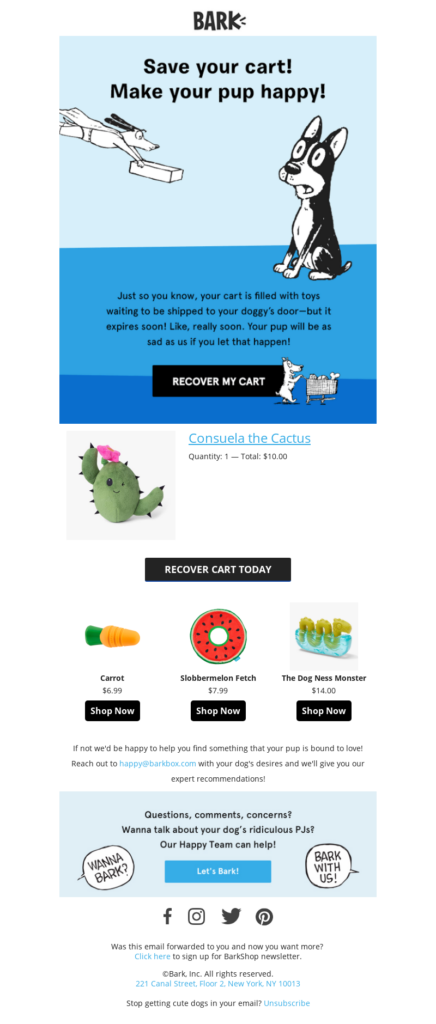
What we love about it:
- Creative angle and strategy for the copywriting, focusing on what the dogs will feel. Even if the dogs aren’t the ones buying the product, it’s a surefire way to encourage the pet parents to go through with the purchase.
- It targets the right emotions. No pet parent who would actually shop for their dogs would want to see them sad.
- The product recommendations’ prices range from low to high which gives customers a good variety to choose from.
- In case you didn’t notice, they have a pretty cute Unsubscribe message, which can make customers think twice.
3. Lewis – Friendliness above all else
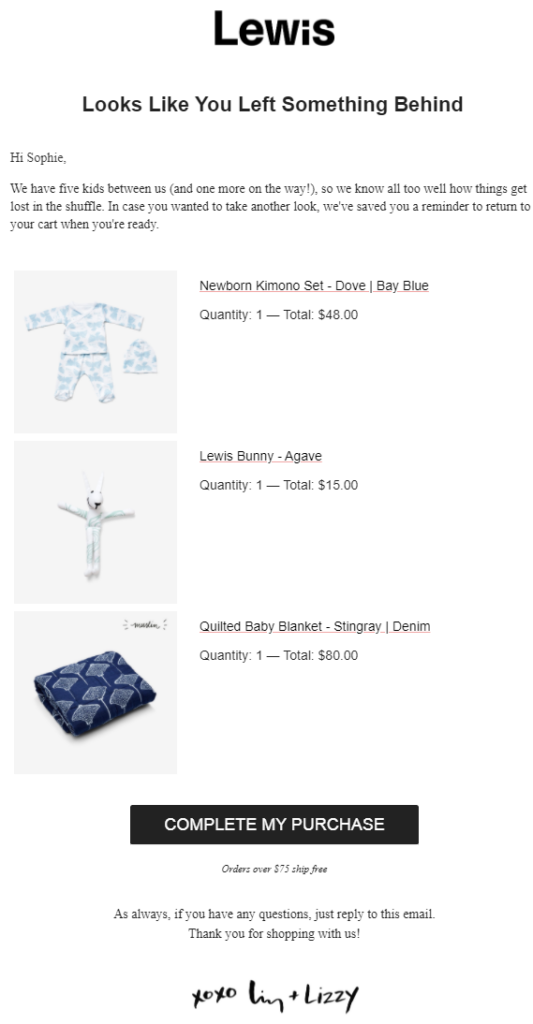
What we love about it:
- The overall tone is very friendly and engaging, which is a far cry from how some emails come across as impersonal.
- The email body itself contains something personal about the business owner as well, blurring the line between customer and business. This can help the customer feel more connected to the brand.
- The signature at the bottom appears to be handwritten, adding to the personalized flair of the email.
4. Puma – Creating a sense of urgency

What we love about it:
- Puma’s signature colors were used cleverly with a striking geometric design to grab the attention of shoppers.
- The email created a sense of scarcity and urgency, mentioning that the items in the cart might go out of stock soon.
- The “Find a Store” button at the top offers an alternative and encourages in-store shopping.
5. Dollar Shave Club – Personality that shines through

What we love about it:
- The look, feel, and tone of the email stays true to the Dollar Shave Club’s branding and personality.
- Copywriting is spot on with the brand too, using words like “Chuck is bummin’ pretty hard.”
- CTA (“Join the Club” is an invitation to belong to a group that helps with customer retention because it promotes a sense of belongingness with the brand.
- Social proof is present, coming from the “members of the club” themselves also known as their customers.
6. Bearsville Soap Company – The non-persuasive route

What we love about it:
- The copy and overall approach are not overly pushy. It simply informs the customer that they can finish the checkout process if they would like to.
- Since the brand sells soap for men, the hero image basically shows what their target audience is all about.
- The cheeky bear emoji in the subject line also nods to their branding.
- It’s simple and straightforward—no frills, just a reminder.
7. Vans – Subtle attempts to sell more

What we love about it:
- The opportunities for cross-selling are presented nicely.
- The simple and minimalist look and feel are consistent with their branding and physical stores
- Copy is clever and encourages the user to continue with the purchase and still add some items.
8. Society6 – Time-based reminder
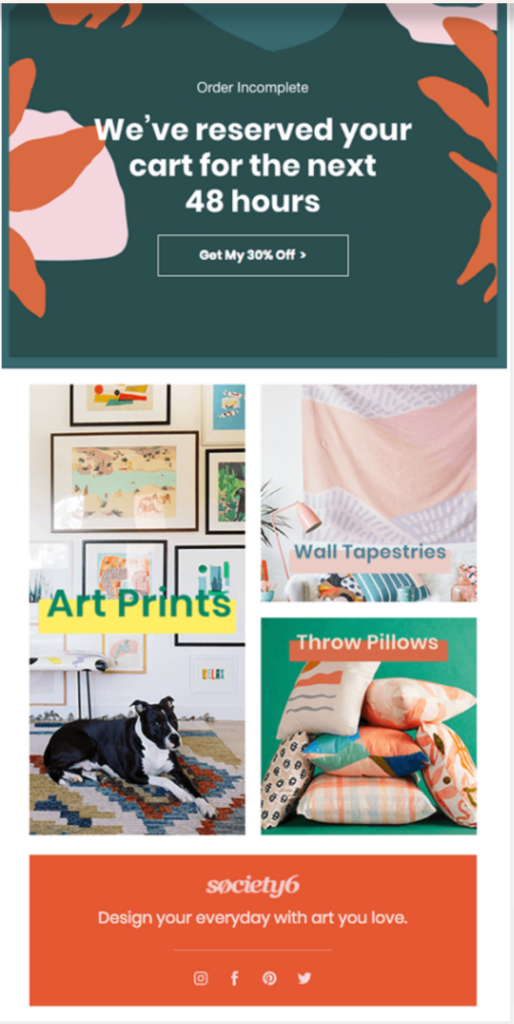
What we love about it:
- The “Order Incomplete” phrase in the header is very clever—it sends a message that the customer forgot something important.
- The 48-hour notice also creates a reminder and a sense of urgency. It is mentioned in the subject line and in the hero image.
- The email design is very clean and clutter-free with a clear message.
9. Lego – The “free shipping” bonus
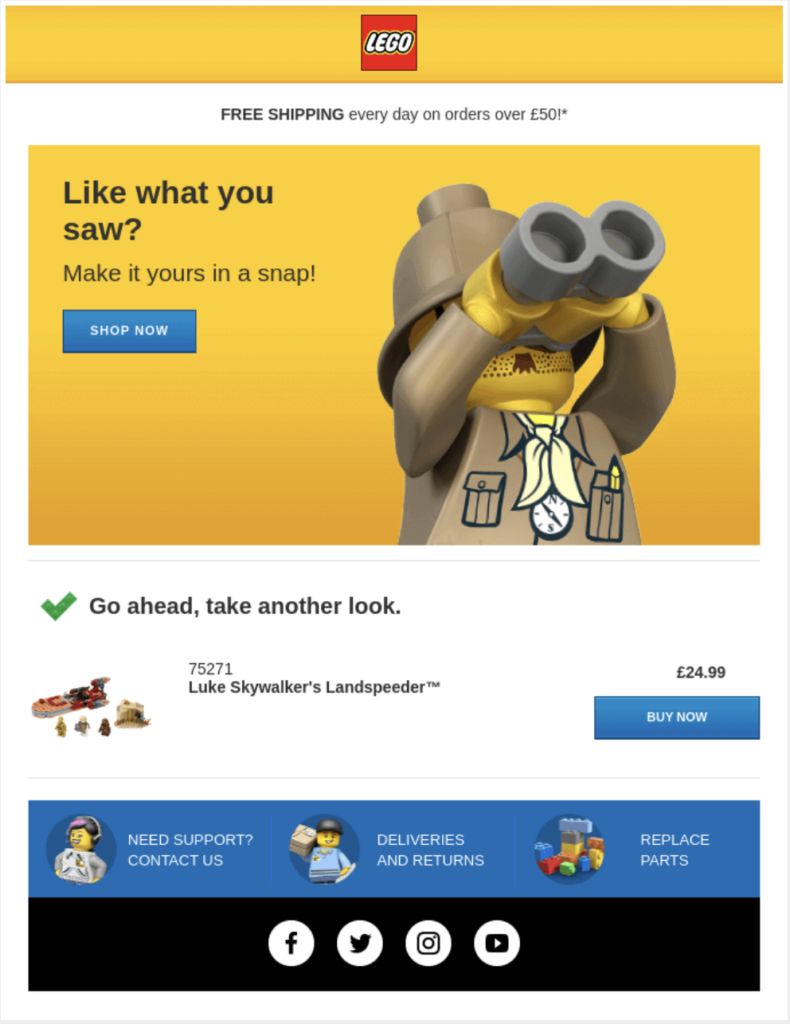
What we love about it:
- Great illustration and simple but punchy copy urge the customer to push through with the purchase.
- Effective placement of CTA buttons provides clarity and direction on what the shopper needs to do next.
- Offers a pero or benefit—in this case, “free shipping” right away. It’s mentioned in the subject line which helps attract email recipients to open the email, and it’s mentioned again right above the fold.
10. Endy – Leveraging social proof
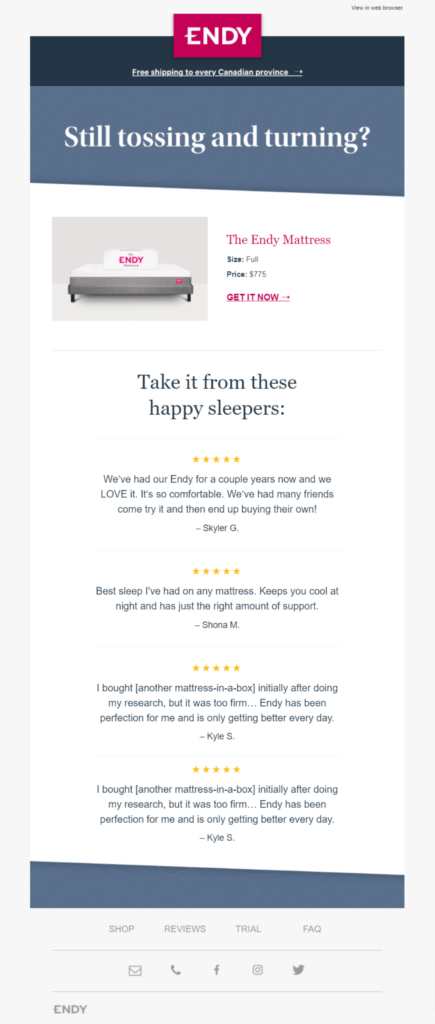
What we love about it:
- It looks simple at first, but it gets more impactful once you start reading it.
- It uses a question for its big introductory text and provides a quick summary of the product left in the shopping cart.
- A big bulk of the email focuses on testimonials and star ratings from “happy sleepers.” Putting social proof front and center helps assure shoppers about the quality of the product.
11. Glossier – Instant attention with a striking image

What we love about it:
- The hero image is literally eye-catching and grabs attention right off the bat.
- Without a photo of the actual product, it doesn’t look like a typical cart abandonment email—which can have its pros and cons.
- The text on the CTA button is creative, unique, and amusing.
- The brand is very transparent about how the email is automatically triggered and pokes fun at this in the copy.
- Short and straight to the point.
12. Figs – Witty and relatable copywriting

What we love about it:
- The headline and sub-headline are very witty as they relate to the target audience’s industry.
- The design is simple and balanced. It is able to present multiple products without looking too cluttered.
- Interestingly, the prices of the products are not shown in the email—which can have pros and cons. This means that customers will definitely go back to their carts if they are interested in these items without price being a deterrent.
13. ThirdLove – Old school but cool

What we love about it:
- It doesn’t have the usual product photos, large CTA buttons, and hero images. Instead, it’s a simple, text-based copy with a few words.
- Since it’s purely a text-based email, it comes across as a personalized email from an actual person and not just a branded email.
- Instead of huge Call to Action buttons, ThirdLove just includes hyperlinks within the actual copy of the email.
- The email starts with a benefit: a $10 credit that the shopper can use however they want. Aside from this being a pleasant surprise, the shopper will also be enticed to read the rest of the email.
The secret sauce to success: 5 ingredients of a great abandoned cart email

A well-crafted cart recovery email is like a potion brewed by a master alchemist. It’s a carefully concocted blend of elements that captivate, resonate, and guide customers back to completing their purchases.
A catchy subject line
Ah, the subject line—a short phrase that determines whether your cart abandonment email will be opened or ignored. It is your first and often last chance to capture your audience’s attention. With over 300 billion emails being sent and received daily worldwide, you need a subject line that will stand out.
Characteristics of a catchy subject line:
- Evokes curiosity and intrigue.
- Conveys urgency or excitement.
- Personalizes the message for the recipient.
- Sets the tone for what’s inside the email.
- Establishes a connection and piques interest.
Tips for crafting your subject lines:
- Curiosity is key. Pose intriguing questions or present a mystery that demands to be solved.
- Inject urgency. Use words like “limited time,” “exclusive offer,” or “last chance” to create a sense of immediacy.
- Keep it concise. Aim for brevity while still conveying the essence of your message.
- Add a touch of personalization. Include the recipient’s name or reference their abandoned items to show that the email is tailored to them.
Visual elements and copywriting

Let’s say your email subject line worked and the user opens your email. What’s next? The overall layout and design should effectively pull in the customer by presenting attractive visuals.
Additionally, a captivating email isn’t just about eye-catching visuals; the words you weave are equally crucial. Compelling email copy can craft a narrative that resonates with the customer’s cart journey. You should be able to address any concerns or objections that led to the abandonment, showcase the value of what they left behind, and drive action with a clear Call to Action (CTA).
Tips for maximizing visual elements and words:
- Opt for a clean layout that guides the eye through the email’s content without overwhelming the space.
- Create an emotional connection with recipients through your concise but clear copy.
- Highlight the abandoned items and make them irresistible.
- Ensure that your visuals align with your brand’s aesthetics and messaging.
- Make sure that your visuals are responsive and look just as bewitching on mobile devices.
Impeccable timing
Timing is everything, and even more so in the world of abandoned carts. Sending the email at the right moment can mean the difference between sparking interest and fading into oblivion. Perfect timing can catch customers while their memory of the abandoned cart is still fresh.
Tips for mastering the timing:
- Leverage automation. Set up triggers to send emails shortly after abandonment, striking while the iron is hot.
- Consider time zones. Send emails during the hours when your target audience is most likely to be active.
- Experiment with follow-ups. Craft a sequence of emails that gradually increase in urgency and offer different incentives.
Persuasive Call to Action (CTA)

The call to action is the gateway to conversion. A persuasive CTA can inspire action and motivate the users to take the next step. However, this doesn’t mean you should flood your email with CTA buttons everywhere. According to Wordstream, emails with only a few elements and one CTA can increase clicks by over 371% and increase sales by around 1,617%. Focus on that one action you want your cart abandoners to do.
Tips for crafting CTAs:
- Use active verbs. Choose verbs that spur action, such as “Complete My Purchase,” “Get My Goodies,” or “Claim My Treasure.”
- Offer benefits. Emphasize what they’ll gain, like “Unlock Exclusive Discounts” or “Secure Your Limited-Edition Item.”
- Add time-sensitive language like “Today Only” or “Offer Expires Soon” to encourage swift action.
- Ensure your CTA button is large enough and easily tappable on mobile devices.
Overall workflow and strategy
A single email is but a thread in this intricate weaving. It’s crucial to design a comprehensive abandoned cart workflow that guides customers from abandonment to conversion. One email must be able fit seamlessly into an entire strategy, and not work as a stand-alone.
Tips for abandoned cart recovery workflows
- Develop a series of emails that gradually build on the previous ones, nurturing the customer’s interest.
- Mix up content. Combine different approaches, such as including educational content, adding customer testimonials, and limited-time offers.
- Segment your audience. Tailor your emails based on customer behavior, preferences, and purchase history. For example, if the customer purchases already from the fourth out of six emails, then they should no longer receive the succeeding emails in the workflow.
- Monitor and adapt. Continuously analyze the performance of your emails and adjust your strategy based on the results.
10 quick tips for a successful abandoned cart email campaign
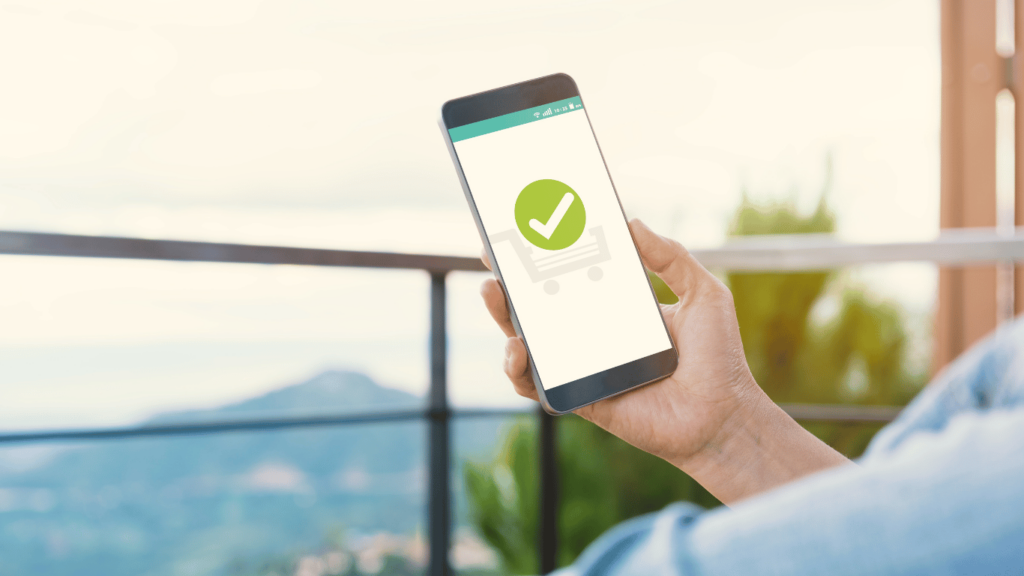
Aside from ensuring that the elements of a successful cart recovery email are present, here are some more tips and a few best practices for implementing your abandoned cart email strategy.
Tip 1: Unleash the power of personalization
- Use their name. Address recipients by their names to create a personalized connection.
- Reference abandoned items. Remind them of what they left behind, making it more likely for them to complete the purchase.
- If you plan on recommending additional products, suggest the items based on the buyers’ preferences to enhance their shopping experience.
Tip 2: Craft compelling subject lines
- Use intriguing questions or convey a sense of urgency to entice recipients to open the email.
- Aim for short and sweet subject lines that convey the main message in a captivating way.
- Experiment with different subject lines to see what works best for your audience.
Tip 3: Showcase social proof
- Include positive reviews or testimonials to build trust and showcase the value of your products.
- User-Generated Content is amazing! Feature photos or feedback from happy customers to create authenticity and social validation.
Tip 4: Mobile-Optimized enchantment
- Design for mobile. Ensure that your emails are responsive and look fantastic on mobile devices, where many customers engage.
- CTA accessibility is underrated. Make your call to action (CTA) buttons large, easy to tap, and prominently displayed on mobile screens.
Tip 5: A dash of exclusivity
- Offer a limited-time discount or exclusive deal to entice recipients to return to their abandoned carts.
- You can’t go wrong with VIP treatment! Make them feel special by treating them to something unique, whether it’s free shipping or a personalized perk.
Tip 6: Create a sense of urgency
- Add a countdown timer to your email, highlighting that the offer won’t last forever.
- Mention the limited availability of the products in their cart to create urgency and encourage FOMO (fear of missing out).
Tip 7: Keep it simple and focused
- Be clear and concise, always. Get to the point and make your email easy to scan, with a clear message and a single, prominent CTA.
- Avoid distractions. Minimize additional links or distractions that might lead the recipient away from completing the purchase.
Tip 8: Test and optimize
- A/B testing is key! Experiment with different elements, such as subject lines, visuals, CTAs, and email copy, to see what drives the best results.
- Analyze performance. Use data and analytics to track the effectiveness of your campaign and make data-driven improvements.
Tip 9: Divide and conquer with the power of segmentation
- Divide your audience based on behavior, preferences, or purchase history to deliver more relevant content.
- Craft personalized emails for each segment, ensuring the content resonates with their unique interests.
Tip 10: Offer something irresistible
- Offer discounts and other incentives (ex. coupon codes, free shipping, reward points, free item, etc.)
- These benefits or perks urge customers to complete their purchase because they’re getting more than what they will pay for
Your journey to cart recovery and revenue recovery awaits

Yes, shopping cart abandonment is one of the biggest challenges of eCommerce businesses. However, it’s important to emphasize that an abandoned cart is not a lost cause. In fact, by properly strategizing your abandoned cart recovery strategy, you can not only recover lost sales but also generate more.
The LTVplus team’s experience in turning abandoned carts into sales involves creating tailored strategies specifically for your business and your customers. If you don’t know where to start or if you need help figuring out a strategy, you can book a free consultation with our experts—we’ll help you get started.




